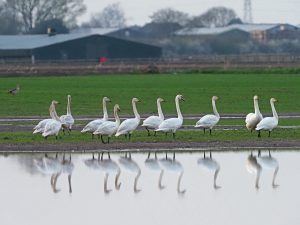
Again, we have had a miserable March. It will be no surprise to hear that the first three months of the year have all been wetter than average; in fact every month from September has been wetter than average. However, we only had 52mm of rain in March, which makes it the driest month so far since September. March has also been very warm, the second warmest in the last 50 years.

There were a couple of days when we were able to work on our fields and in those two days we drilled 40 acres of sugar beet, 45 acres of beans and 40 acres of spring barley. We need many more days of dry weather to complete our spring drilling.
When it dries out enough, we will be planting potatoes as that is our most profitable crop. Spring barley and spring beans drilled in April are not crops to earn any money.
Often, when we get unusual weather events, we say: ‘we have seen it all before’. This time it is unique, as it has been the wettest winter for 200 years. We will have to be very careful what we do, as we now have very big machinery and if it gets bogged down, it takes a lot to pull it out. There is still sugar beet in the ground and a local contractor has had his sugar beet harvester stuck twice now. One of those times, it took two days to get it pulled out and then there was considerable damage to the machine.
We still have a lot of wheat, beans and potatoes to deliver. Prices for our wheat barley and beans are very low, as there is over production world-wide. The price we get for our wheat and barley is much the same as farmers elsewhere in the world.
All farmers in this country have to conform to the red tractor regulations. Every year we get inspected to make sure we are producing crops to a high standard, which involves checking which sprays we have used, checking that we have tested the quality of the water used for irrigation, keeping records when we cleaned the combine out and numerous other regulations. We have to do this to make sure that the food we send to market is good, wholesome food. Conforming to all these regulations and keeping the records puts our cost of production up, but makes sure we produce healthy food. This is what British farmers have been protesting about: imported food of unknown origin.


Most of our winter visitors have departed and our summer visitors have only just started to arrive. The first one is usually the Chiffchaff, a member of the warbler family, and they have been singing since the middle of March. They are a very small and inconspicuous brown bird that you wouldn’t know was here if it wasn’t singing. That is the same with most of the warblers, you wouldn’t know most of them are here until they sing. They all winter in Africa and return singly, the first ones arriving the same time as others of the same species. None of them eat cereals, they are all insectivorous, but their numbers are keeping up in most cases.
One bird that is often overlooked as being a migrant is the Goldfinch. About half of the UK’s population of Goldfinches migrate to Spain and they have already returned. Several people have said to me that they have had an increase in Goldfinches over the last week or two, and we’ve had an increase in the Vine House Farm garden as well.
Over the past few weeks, it has been interesting watching the birds on our wetland. The Wigeon have now gone, and some Teal will stay until the middle of April. Shoveler have been there all winter and I expect about five pairs to stop and breed. Gadwall have been absent all winter, but there are now three pairs on site as well as a pair of Shelducks. Lapwings and Oystercatchers arrived at the end of February and this last week I have seen Lapwings sitting in the grass in an exposed place, so they might be on eggs already.
Redshanks and Oystercatchers will lay eggs during April. Redshank numbers are up, I counted 12 on March 30th, so we have at least six pairs this year. Lapwings and Oystercatchers nest in an exposed place, so they can see danger coming when sitting on eggs, whereas Redshanks will make a nest in a tuft of grass so that we cannot see them; they are of course quite camouflaged themselves. They will be able to see danger coming through the grasses they are nesting in and leave quietly if necessary.
Black Headed Gulls have also arrived back on the wetland and are also at our reservoir in much reduced numbers, as they suffered from bird flu last year. I used to just tolerate them, but now I am very pleased to have them as when they arrived at our wetland in 2022, nearly every species bred successfully. Winged predators were kept away by the Gulls, including Herons which I believe were our main predator. If it moves and can be swallowed, the Heron will have it.
I am hoping that Common Terns will be arriving at our reservoir. Last year they also had bird flu, but they did produce young. They will nest on a raft we have prepared for them which will be floating next to the shore. The Black Headed Gulls start nesting in mid-April, so we shall pull the raft in the reservoir around the first of May, when the Gulls have their nests on the island.
Farm Tours
Wetland Tour 27th April
Farm Tour 4th, 18th & 25th May
Farm Tour 15th June, 6th July
Sunflower Farm Tour 3rd, 10th & 11th Aug



